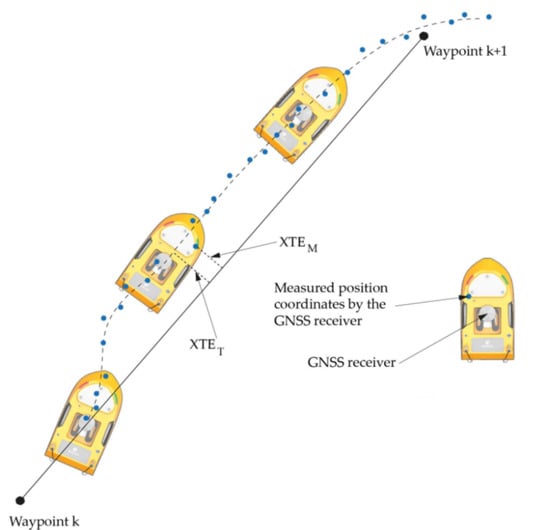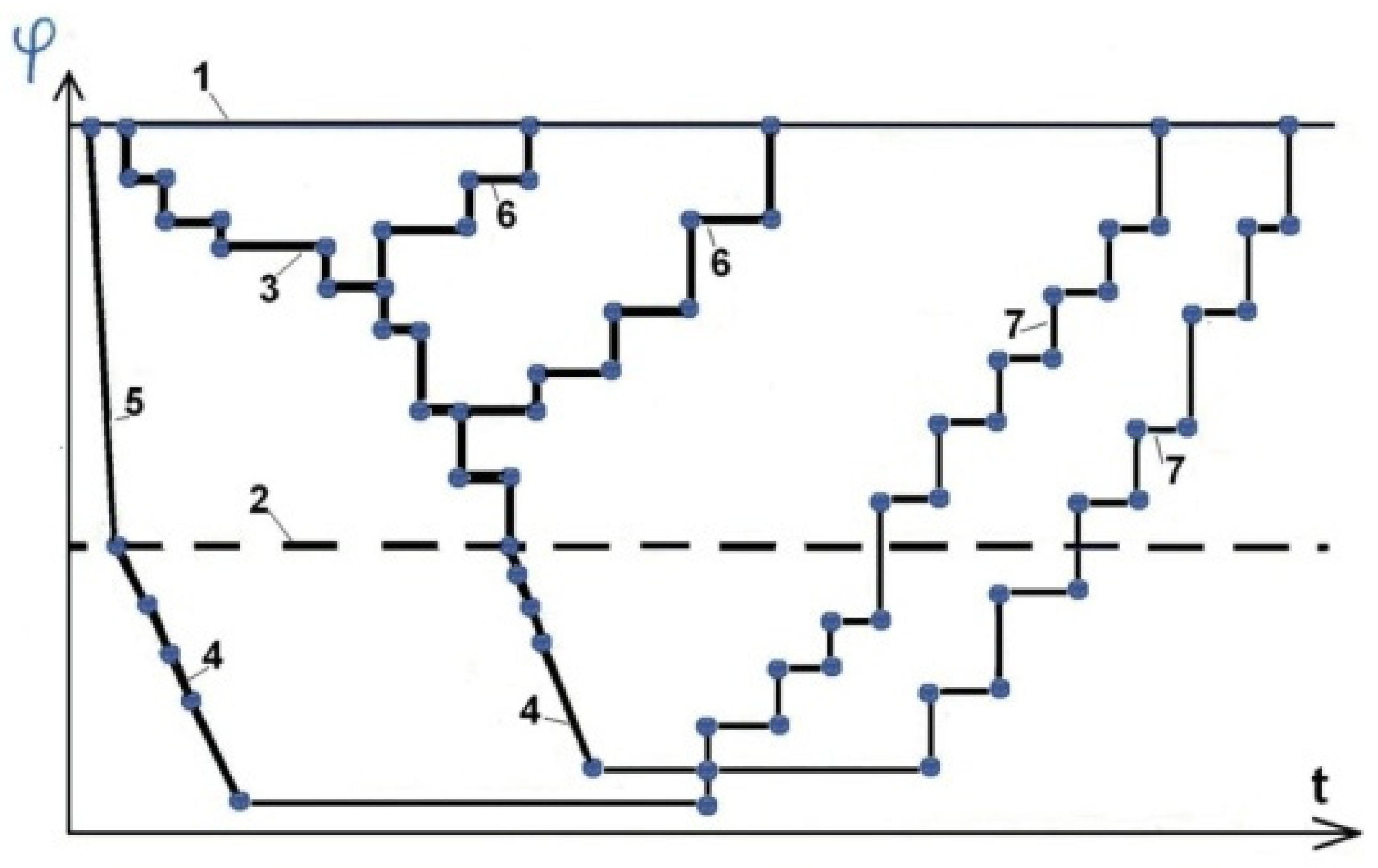Electric Power System Transformations: A Review of Main Prospects and Challenges
Abstract
1. Introduction
2. Structural Trends in the EPS Development
- warranted access to electric power of EPSs as an infrastructure system at any time, in any amount, at required reliability and quality;
- availability of starting currents to start up large electric engines and power plants that lost power for ancillary services in the course of an emergency;
- provision of high-quality voltage and frequency;
- higher efficiency of EPS operation;
- ability to select counteragents and to minimize local monopolism of separate segments of the electric power market.
- In Europe:
- -
- Kitnos (Greece) with decentralized intelligent load control;
- -
- Mannheim (Germany)—transition from joint operation with EPS to islanded operation;
- -
- Bronsberger (Netherlands)—islanded operation of a micro-system and of an intelligent electric storage facility.
- In Japan:
- -
- demonstration projects of micro-systems, including a demonstration project in New Mexico.
- In China:
- -
- micro-systems on islands, in industrial, commercial and residential areas and in remote areas.
- In the USA:
- -
- a roadmap of studies and demonstration projects of power supply micro-systems.
3. Transformation of the Future EPS Properties under the Influence of Innovative Technologies. EPS Flexibility
4. Possible Measures for Flexibility Enhancement of the Future EPSs
- As was noted above, frequency characteristics of speed and frequency control systems of conventional synchronous generators play a major role in ensuring the EPS flexibility as they enhance the self-adaptation and self-stabilization ability of systems for damping the negative impact of internal and external factors. The flexibility of generating units can additionally be enhanced by a higher speed of loading and unloading, by their deeper unloading, by maintenance of the required levels of rotating and operating reserves of active generating capacity, by reliable fuel supply for power plants and by power plant restoration from the “black-start” level in the case of auxiliary power loss due to faults.
- The flexibility of transmission and distribution networks can be enhanced by the liquidation of weak points in the network, by the reduction of transfer capability constraints of weak cutsets and by a higher efficiency of using the transfer capability of weak links. The application of FACTS devices, which are manufactured now by various companies [30], whose control systems allow for the stabilization of EPS mode variables and maintain the required transfer capability margins of links in normal, maintenance, emergency and post-emergency conditions, is a reliable means to ensure that. Higher flexibility of active transmission and distribution electric networks can be ensured by automatic reconfiguration of the network [31].
- Load flexibility is ensured by the abovementioned frequency and voltage control effects, by automatic load control owing to shifting the controllable electric facilities to the zone of a minimum daily load curve [32] and by using the distributed generation units available with the consumers (prosumers) [33].
- Power storages of different capacities and energy intensities will play a major role in enhancing the EPS flexibility, particularly in the case of random fluctuations in power supply by units based on renewable energy sources (RESs) at all levels, i.e., in super, mini- and micro-systems [34].
- Integrated multi-energy systems allow for additional means for enhancing the EPS flexibility when using units generating the required type of energy by the use of another type of energy (for example, heat pumps, electric boilers, etc.) [35]. Innovative gas supply systems within integrated energy systems allow for further enhancement of power generation flexibility owing to more efficient gas-based technologies, especially with the combined production of heat and power [33,35].
- Efficient protection and control systems play a key role in ensuring the EPS flexibility [36]. The efficiency of those systems when using the intelligent technologies can be notably enhanced by raising the accuracy of EPS state variable forecasts, by the reduction of time for preparation of control actions, and by raising the frequency of their implementation [28].
- In this connection, a detailed review given in [37] is worth mentioning that gives 393 names of quoted papers. The authors analyze practically all the above listed measures for enhancing the EPS flexibility.
- The use of market mechanisms is an efficient means for stimulating the EPS flexibility enhancement [38].
5. Resiliency and Survivability of EPSs
6. Possible Measures for Enhancing the Resiliency/Survivability of EPSs
- Elaboration of reliability standards for submission of the reliability requirements when planning the EPS development and condition control; it is necessary to note the necessity of elaborating special reliability standards for the cases of natural disasters with the identification of specific requirements for the power supply reliability of major consumers in those conditions;
- Creation of a large-scale efficient protection system and emergency control system that is primarily important for preventing the cascade propagation of an emergency;
- Development of efficient procedures for EPS recovery after large disturbances. It is obvious that those procedures shall be different for the cases of system recovery after a cascade emergency and after natural disasters;
- Organization of regular training for dispatchers. The contents of that training shall be different for the cases of a cascade emergency and for natural disasters;
- Generalization of the nature and mechanisms of occurrence and development of large emergencies. Each system cascade emergency is unique but their analysis and generalization allow for the identification of the key factors whose elimination would reduce the probability of such emergencies and mitigate their probable consequences. Considering the basic importance of such generalizations, let us consider this aspect of the problem in greater detail.
7. Analysis of Cascading Emergency Mechanisms and EPS Restoration
- Several of the most characteristic events and stages of occurrence, and cascade propagation of the system emergency, are to be singled out: initial disturbance (initiating event); cascade process of the emergency propagation with implementation of control actions to prevent the steady-state progression; marginal state (“point of no return”); a triggering event; catastrophic uncontrollable avalanche-like high-speed cascade; EPS restoration (Figure 7) [44].
- The authors of [47], on the basis of statistics of large emergencies in North America in 1984–2006, analyze a number of hypotheses and discard the hypotheses on frequency reduction of such emergencies with time; on independence of the frequency of emergencies from the season of the year; on independence of the frequency of emergencies from the time of the day; on the correlation between the scale of the emergency consequences and time for the system restoration.
- The authors of [42,44,48,49,50] stress the decisive role of emergency control systems in preventing the occurrence of emergencies, in opposing the propagation of heavy emergencies and in rapid restoration of the system. An emergency control system is to perform three groups of functions: prevention of a cascade emergency in the pre-emergency conditions; adaptive opposition to emergency propagation; adjusting the control in the post-emergency conditions;
- The role of the EPS restoration process step by step from the final state with the active participation of a dispatcher and by an automatic emergency control means [42,43,44,48,49,50,51,52]. The restoration process shall not be interrupted by irrational control actions that aggravate the emergency situation.
8. Cyber-Physical EPSs
9. Development Trends of EPS Management and Control Systems
- wide area monitoring, protection and control systems (WAMS, WAPS and WACS);
- ideology implemented on the basis of phasor measurements of EPS state variables;
- present-day data transfer;
- processing and visualization means for monitoring current operating conditions;
- adaptive methods for generating the control actions. Adaptation in this case is based on prediction, which requires the use of applicable methods for forecasting the EPS state variables.
10. Concluding Remarks
Funding
Conflicts of Interest
References
- Voropai, N.I.; Osak, A.B. Electric power systems of the future. Energeticheskaya Polit. 2014, 5, 22–29. (In Russian) [Google Scholar]
- Marvasti, A.K.; Fu, Y.; DorMohammadi, S.; Rais-Rohani, M. Optimal Operation of Active Distribution Grids: A System of Systems Framework. IEEE Trans. Smart Grid 2014, 5, 1228–1237. [Google Scholar]
- Quint, R.; Dangelmaier, L.; Green, I.; Edelson, D.; Ganugula, V.; Kaneshiro, R.; Pigeon, J.; Quaintance, B.; Riesz, J.; Stringer, N. Transformation of the Grid: The Impact of Distributed Energy Resources on Bulk Power Systems. IEEE Power Energy Mag. 2019, 17, 35–45. [Google Scholar]
- Voropai, N.I.; Stennikov, V.A. Integrated smart energy system. Izv. RAN Energ. 2014, 1, 64–72. (In Russian) [Google Scholar]
- Ackermann, T.; Andersson, G.; Söder, L. Distributed generation: A definition. Electr. Power Syst. Res. 2001, 57, 195–204. [Google Scholar]
- Marnay, C.; Nordman, B.; Lai, J. Future roles of mili-, micro-, and nano-grids. In Proceedings of the CIGRE Symposium “Electric Power System for the Future—Integrating Supergrids and Microgrids”, Bologna, Italy, 13–15 September 2011. [Google Scholar]
- Microgrids: Architectures and Control; Hatziargiriou, N., Ed.; IEEE Press-Wiley: New York, NY, USA, 2014. [Google Scholar]
- Marnay, C.; Abbey, C.; Joos, G. Microgrids 1: Engineering, economics, and experience—Capabilities, benefits, business opportunities and examples—Microgrids evolution roadmap. Electra 2015, 283, 71–75. [Google Scholar]
- Ershevich, V.V.; Antimenko, Y.L. Operation efficiency of Unified electric power system on the territory of former USSR. Izv. RAN. Energ. 1993, 1, 22–31. (In Russian) [Google Scholar]
- Voropai, N.I.; Podkovalnikov, S.V.; Osintsev, K.A. From interconnections of local electric power systems to Global Energy Interconnection. Global Energy Interconnect. 2018, 1, 4–10. [Google Scholar]
- Commission of the European Communities. The Benefits of Integration in the European Electricity System; Work Document; Commission of the European Communities: Brussels, Belgium, 1990. [Google Scholar]
- Voropai, N.I.; Trufanov, V.V.; Selifanov, V.V.; Sheveleva, G.I. About the efficiency analysis of Unified electric power system of Russia. Elektrichestvo 2000, 5, 2–9. (In Russian) [Google Scholar]
- Opadchy, F. The Necessity in the Large Power Systems Does not Decrease, but Increase, Interview of Vice-President of International Association for System Operators G015 F. Elektroenergiya. Peredacha Raspred. 2020, 1, 146–150. (In Russian) [Google Scholar]
- Mano, S.; Ovgor, B.; Samadov, Z. Gobitec and Asian Super Grid for Renewable Energies in Northeast Asia. Available online: https://www.renewable-ei.org/images/pdf/20140124/gobitec_and_ASG_report_ENG_BOOK_final.pdf (accessed on 15 October 2015).
- Deng, C.; Song, F.; Chen, Z. Preliminary study on the exploitation plan of the mega hydropower base in the lower reaches of Congo River. Glob. Energy Interconnect. 2020, 3, 12–22. [Google Scholar]
- Strbac, G.; Pudjianto, D.; Aunedi, M.; Papadaskalopoulos, D.; Djapic, P.; Ye, Y.; Moreira, R.; Karimi, H.; Fan, Y. Cost-Effective Decarbonization in a Decentralized Market: The Benefits of Using Flexible Technologies and Resources. IEEE Power Energy Mag. 2019, 17, 25–36. [Google Scholar]
- Liu, Z. Global Energy Interconnection; Elsevier: Amsterdam, The Netherlands, 2015. [Google Scholar]
- Jacobson, M.Z.; Delucchi, M.A.; Cameron, M.A.; Coughlin, S.J.; Hay, C.A.; Manogaran, I.P.; Shu, Y.; Von Krauland, A.-K. Impacts of Green New Deal Energy Plans on Grid Stability, Costs, Jobs, Health, and Climate in 143 Countries. One Earth 2019, 1, 449–463. [Google Scholar]
- Liu, Z. Ultra-High Voltage AC/DC Grids; Elsevier: Amsterdam, The Netherlands, 2015. [Google Scholar]
- Bushuev, V.V. Energy-information systems as the basis of neo-industrial and socio-humanitarial civilization. Energeticheskaya Polit. 2016, 3, 7–24. (In Russian) [Google Scholar]
- Gerasimov, A.C.; Esipovich, A.K.; Koshcheev, L.A.; Sulginov, N.G. Operating conditions study of Moscow power system during emergency development at May 2005. Elektrichestvo 2008, 1, 2–12. (In Russian) [Google Scholar]
- Paris, L.; Valtorta, M.; Manzoni, E.A. Rapport de la mission d’enquete sur la panne d’electricite du 19 decembre 1978. Electr. France 1979, 1, 31–49. [Google Scholar]
- Paris, L.; Zini, G.; Valtorta, M.; Manzoni, G.; Invernizzi, A.; De Franco, N.; Vian, A. Present limits of very long distance transmission systems. In Proceedings of the CIGRE 1984 Session, Paris, France, 29 August–6 September 1984; pp. 37–112. [Google Scholar]
- Mueller, H.-C.; Haubrich, H.-J.; Schwarz, J. Technical limits of interconnected systems. In Proceedings of the CIGRE 1992 Session, Paris, France, 30 August–5 September 1992; pp. 37–301. [Google Scholar]
- Amin, M. Challenges in reliability, security, efficiency, and resilience of energy infrastructure: Toward smart self-healing electric power grid. In Proceedings of the 2008 IEEE Power and Energy Society General Meeting—Conversion and Delivery of Electrical Energy in the 21st Century, Pittsburgh, PA, USA, 20–24 July 2008. [Google Scholar]
- Voropai, N.I.; Bat-Undraal, B.; Enkhsaikhan, E. Ways and problems of micro-systems of power supply of isolated consumers in Mongolia. Izv. RAN Energ. 2019, 6, 43–50. (In Russian) [Google Scholar]
- Vassiliev, S. Green roofs of Russia or micro-generation in Russia. Energy Econ. Tech. Ecol. 2018, 5, 69–72. (In Russian) [Google Scholar]
- Voropai, N.; Rehtanz, C. Flexibility and Resiliency of Electric Power Systems: Analysis of Definitions and Content. In Proceedings of the EPJ Web of Conferences, International Workshop on Flexibility and Resiliency of Electric Power Systems, Irkutsk, Russia, 26–30 August 2019. [Google Scholar]
- Marceau, R.J.; Endrenyi, J.; Allan, R.; Alvarado, F.L. Power system security assessment: A position paper. Electra 1997, 175, 49–77. [Google Scholar]
- Zhang, X.-P.; Rehtanz, C.; Pal, B.C. Flexible AC Transmission Systems: Modelling and Control; Springer: Berlin, Germany, 2012. [Google Scholar]
- Sun, H.; Wang, Y.; Nikovski, D.; Zhang, J. Flex-Grid: A dynamic and adaptive configurable power distribution system. In Proceedings of the 2015 IEEE Eindhoven PowerTech, Eindhoven, The Netherlands, 29 June–2 July 2015. [Google Scholar]
- Chulyukova, M.; Voropai, N. Flexibility Enhancement in an Islanded Distribution Power System by Online Demand-Side Management. In Proceedings of the EPJ Web of Conferences, International Workshop on Flexibility and Resiliency of Electric Power Systems, Irkutsk, Russia, 26–30 August 2019. [Google Scholar]
- Chen, X.; Kang, C.; O’Malley, M.; Xia, Q.; Bai, J.; Liu, C.; Sun, R.; Wang, W.; Li, H. Increasing the Flexibility of Combined Heat and Power for Wind Power Integration in China: Modeling and Implications. IEEE Trans. Power Syst. 2015, 30, 1848–1857. [Google Scholar]
- Styczynski, Z.; Adamek, F.; Irovani, F.; Voropai, N. Electric Energy Storage System. CIGRE Brochure, WG C6.15; CIGRE Brochure: Paris, France, 2011.
- Koeppel, G.; Andersson, G. The influence of combined power, gas, and thermal networks on the reliability of supply. In Proceedings of the 6th World Energy System Conference, Torino, Italy, 10–12 July 2006. [Google Scholar]
- Shulginov, N.G.; Pavlushko, S.A.; Dyachkov, V.A. Effective control of electric power operating modes of UES of Russia in current conditions. Energetik 2013, 6, 20–24. (In Russian) [Google Scholar]
- Lund, P.D.; Lindgren, J.; Mikkola, J.; Salpakari, J. Review of energy system flexibility measures to enable high levels of variable renewable electricity. Renew. Sustain. Energy Rev. 2015, 45, 785–807. [Google Scholar] [CrossRef]
- Bistline, J. Turn Down for What? The Economic Value of Operational Flexibility in Electricity Markets. IEEE Trans. Power Syst. 2018, 34, 527–534. [Google Scholar] [CrossRef]
- Nan, C.; Sansavini, G.; Kröger, W.; Sansavini, G. Building an Integrated Metric for Quantifying the Resilience of Interdependent Infrastructure Systems. In Proceedings of the 9th International Conference on Critical Information Infrastructure Security, Limassol, Cyprus, 13–15 October 2011. [Google Scholar]
- Wang, Y.; Chen, C.; Wang, J.; Baldick, R. Research on resilience of power systems under natural disasters—A review. IEEE Trans. Power Syst. 2016, 31, 1604–1612. [Google Scholar] [CrossRef]
- Panteli, M.; Mancarella, P.; Trakas, D.N.; Kyriakides, E.; Hatziargyriou, N.D. Metrics and Quantification of Operational and Infrastructure Resilience in Power Systems. IEEE Trans. Power Syst. 2017, 32, 4732–4742. [Google Scholar] [CrossRef]
- Kezunovic, M.; Overbye, T.J. Off the Beaten Path: Resiliency and Associated Risk. IEEE Power Energy Mag. 2018, 16, 26–35. [Google Scholar] [CrossRef]
- Voropai, N.I. The problem of large electric power system survivability. In Proceedings of the IEEE Power Tech, Stockholm, Sweden, 18–22 July 1995. [Google Scholar]
- Besanger, Y.; Eremia, M.; Voropai, N. Major grid blackouts: Analysis, classification, and prevention. Handbook of Electrical Power System Dynamics: Modeling, Stability, and Control; IEEE Press-Wiley: Hoboken, NJ, USA, 2013; pp. 789–863. [Google Scholar]
- Sovalov, S.A.; Semenov, V.A. Emergency Control in Power Systems; Energoatomizdat: Moscow, Russia, 1988. [Google Scholar]
- Bialek, J.W. Blackouts in the US / Canada and continental Europe in 2003: Is liberalisation to blame? In Proceedings of the 2005 IEEE St. Petersburg Power Tech, St. Petersburg, Russia, 27–30 June 2005. [Google Scholar]
- Hines, P.; Apt, J.; Talukdar, S. Large blackouts in North America: Historical trends and policy implications. Energy Policy 2009, 37, 5249–5259. [Google Scholar] [CrossRef]
- Pourbeik, P.; Kundur, P.; Taylor, C. The anatomy of a power grid blackout—Root causes and dynamics of recent major blackouts. IEEE Power Energy Mag. 2006, 4, 22–29. [Google Scholar] [CrossRef]
- Martins, A.C.B.; Gomes, P.; Alves, F. Lessons learned in restoration from recent blackout incidents in Brazilian power system. In Proceedings of the CIGRE 2012 Session, Paris, France, 25–30 August 2011. [Google Scholar]
- Li, B.; Gomes, P.; Baumann, R. Lessons learnt from recent emergencies and blackout incidents. Electra 2015, 279, 66–73. [Google Scholar]
- Feltes, J.; Grande-Moran, C. Down, but Not Out: A Brief Overview of Restoration Issues. IEEE Power Energy Mag. 2014, 12, 34–43. [Google Scholar] [CrossRef]
- Che, L.; Khodayar, M.; Shahidehpour, M. Only Connect: Microgrids for Distribution System Restoration. IEEE Power Energy Mag. 2014, 12, 70–81. [Google Scholar]
- Voropai, N.I.; Kolosok, I.N.; Korkina, E.S.; Osak, A.B. Cyber-physical electric power systems: Transformation of properties and new problems. Avtom. I IT Energetike 2018, 110, 31–35. (In Russian) [Google Scholar]
- Voropai, N.I.; Gubko, M.V.; Kovalev, S.P.; Massel, L.V. Development problems of digital energetics in Russia. Probl. Upr. 2019, 1, 2–14. (In Russian) [Google Scholar]
- Mehrdad, S.; Mousavian, S.; Madraki, G.; Dvorkin, Y. Cyber-Physical Resilience of Electrical Power Systems Against Malicious Attacks: A Review. Curr. Sustain. Energy Rep. 2018, 5, 14–22. [Google Scholar] [CrossRef]
- Hull, J.; Khurana, H.; Markham, T.; Staggs, K. Staying in control: Cybersecurity and the modern electric grid. IEEE Power Energy Mag. 2011, 10, 41–48. [Google Scholar] [CrossRef]
- Khaitan, S.K.; McCalley, J.D. Cyber physical system approach for design of power grids: A survey. In Proceedings of the 2013 IEEE Power & Energy Society General Meeting, Vancouver, Canada, 21–25 July 2013. [Google Scholar]
- Cai, Y.; Cao, Y.; Li, Y.; Huang, T.; Zhou, B. Cascading Failure Analysis Considering Interaction Between Power Grids and Communication Networks. IEEE Trans. Smart Grid 2016, 7, 530–538. [Google Scholar] [CrossRef]
- Ashby, W.R. An Introduction to Cybernetics; Chapman and Hall: London, UK, 1957. [Google Scholar]
- Fardanesh, B. Future trends in power system control. IEEE Comput. Appl. Power 2002, 15, 24–31. [Google Scholar] [CrossRef]
- Ilic, M.; Allen, H.; Chapman, W.; King, C.; Lang, J.; Litvinov, E. Preventing Future Blackouts by Means of Enhanced Electric Power Systems Control: From Complexity to Order. Proc. IEEE 2005, 93, 1920–1941. [Google Scholar] [CrossRef]
- Ruano, A.; Ge, S.S.; Guerra, T.M.; Lewis, F.L.; Principe, J.; Colnaric, M. Computational intelligence in control. In Proceedings of the 19th IFAC World Congress, Cape Town, South Africa, 24–29 August 2014. [Google Scholar]
- Voropai, N.I.; Kurbatsky, V.G.; Tomin, N.V.; Panasetsky, D.A. Intelligent Software for Preventing Large Emergencies in Power Systems; Nauka: Novosibirsk, Russia, 2016. (In Russian) [Google Scholar]
- Gerasimov, A.S.; Koshcheev, L.A.; Kritskiy, V.A.; Lisitsyn, A.A. Automatic emergency control in power systems. Elektr. Stantsyji 2020, 1, 41–49. (In Russian) [Google Scholar]
- Olfati-Saber, R.; Fax, J.A.; Murray, R.M. Consensus and Cooperation in Networked Multi-Agent Systems. Proc. IEEE 2007, 95, 215–233. [Google Scholar] [CrossRef]
- Qin, J.; Wan, Y.; Yu, X.; Li, F.; Li, C. Consensus-Based Distributed Coordination Between Economic Dispatch and Demand Response. IEEE Trans. Smart Grid 2018, 10, 3709–3719. [Google Scholar] [CrossRef]
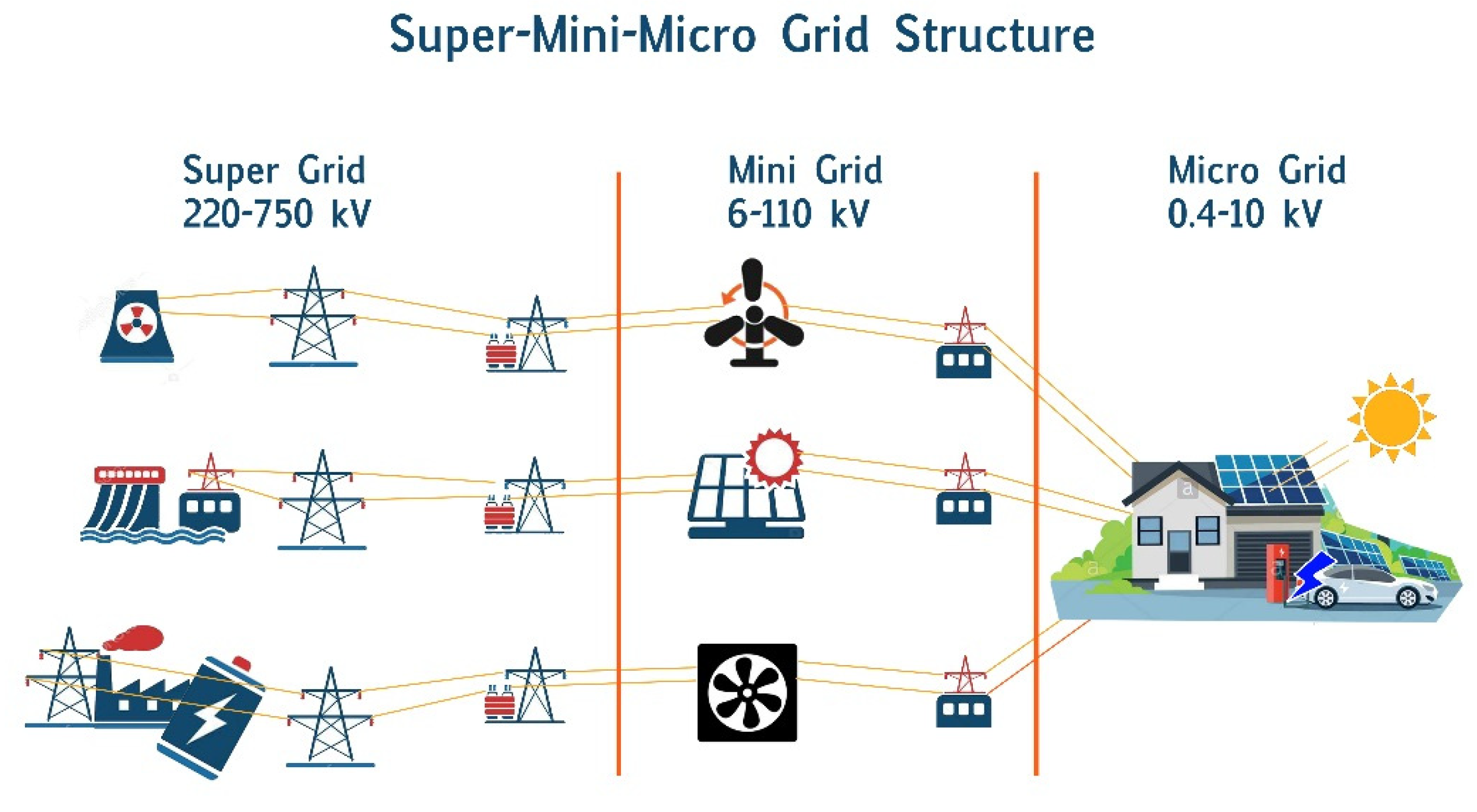
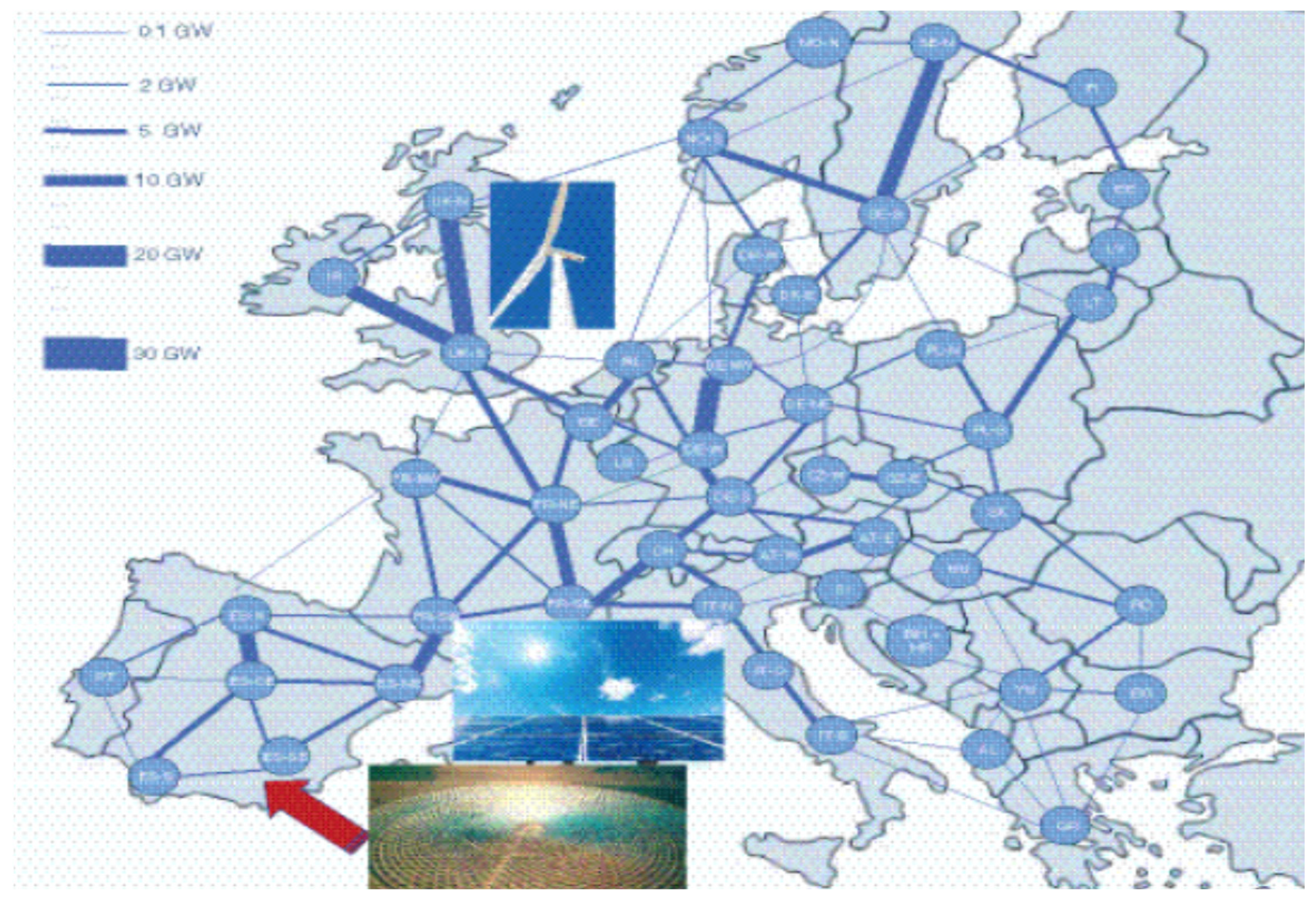
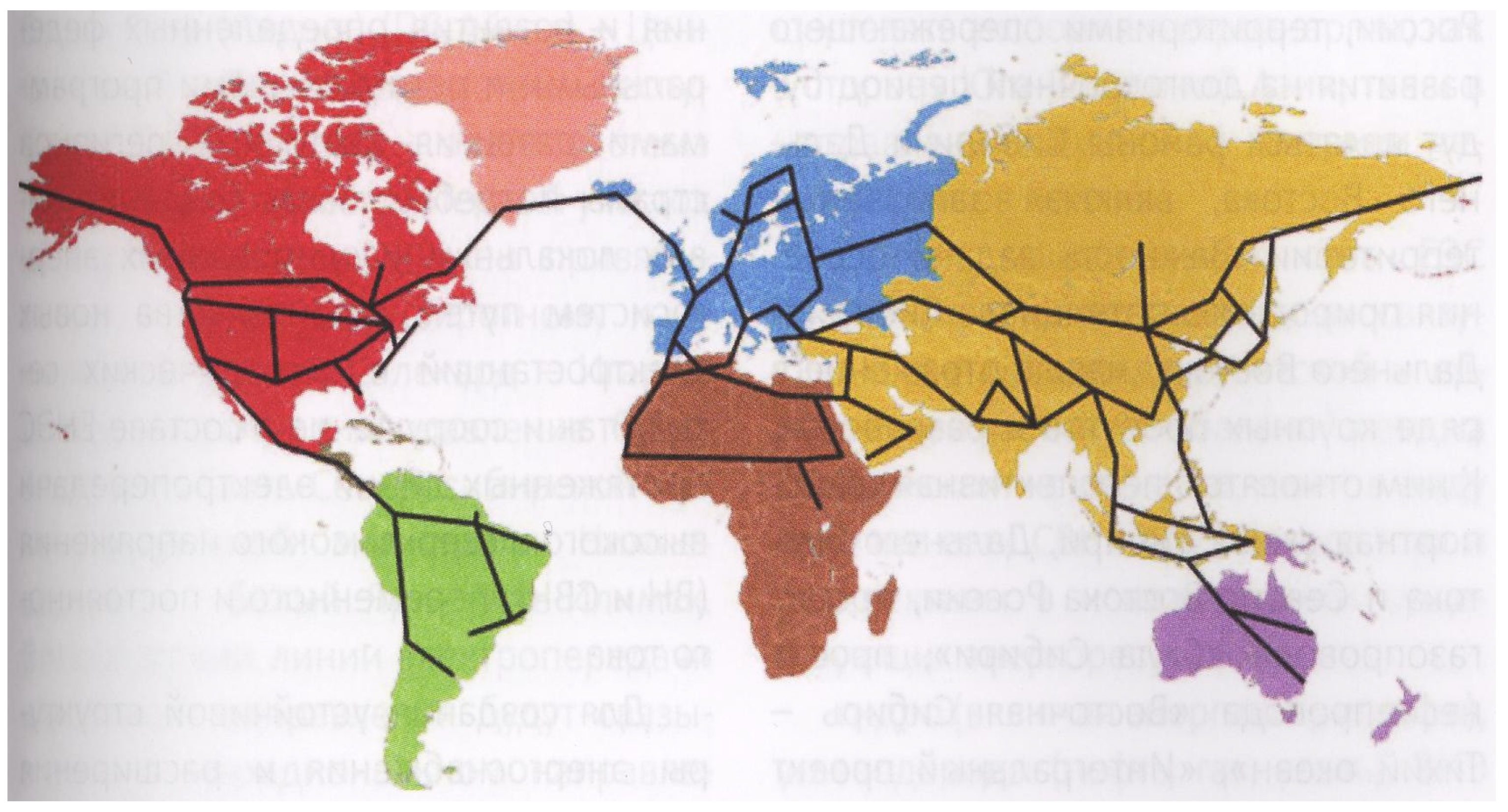
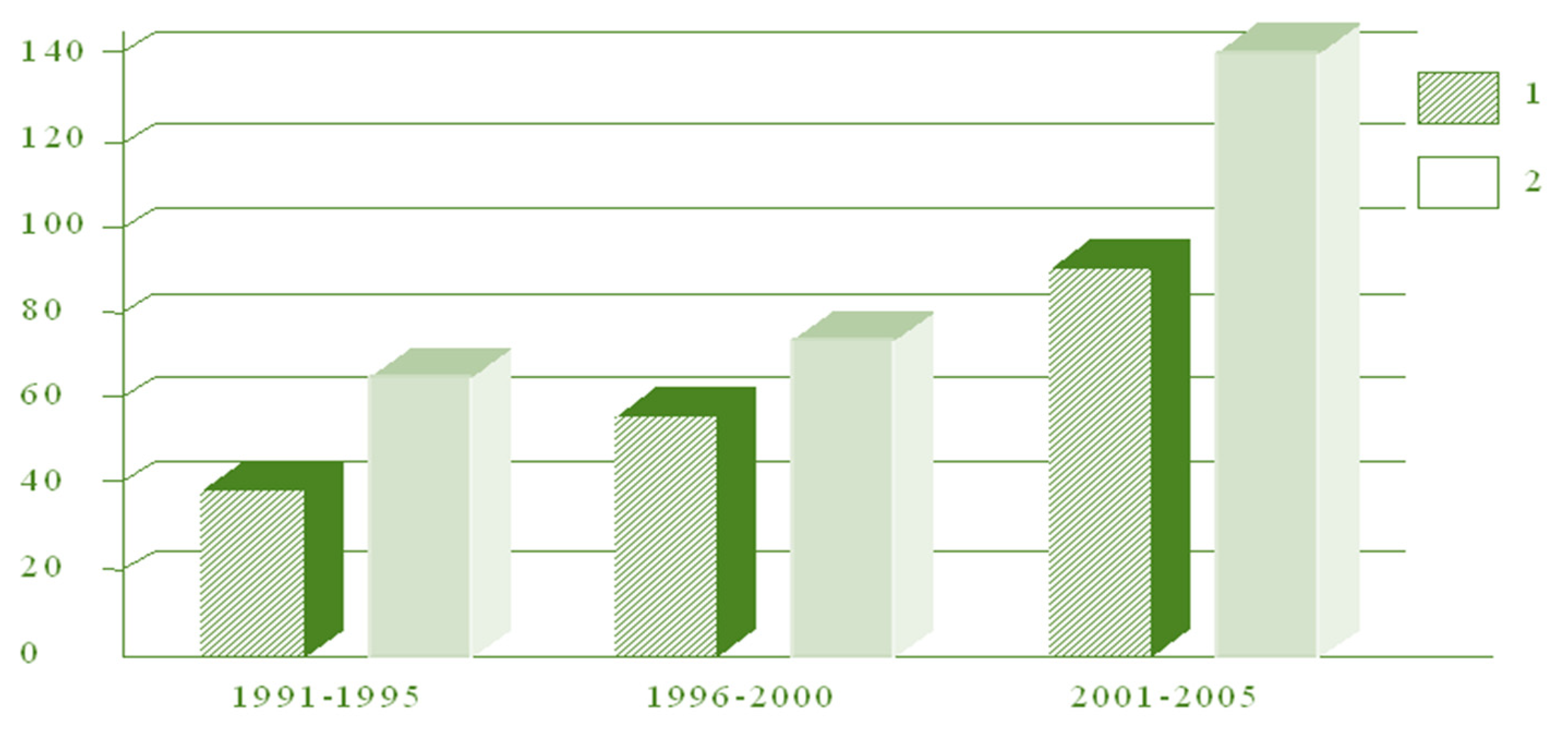
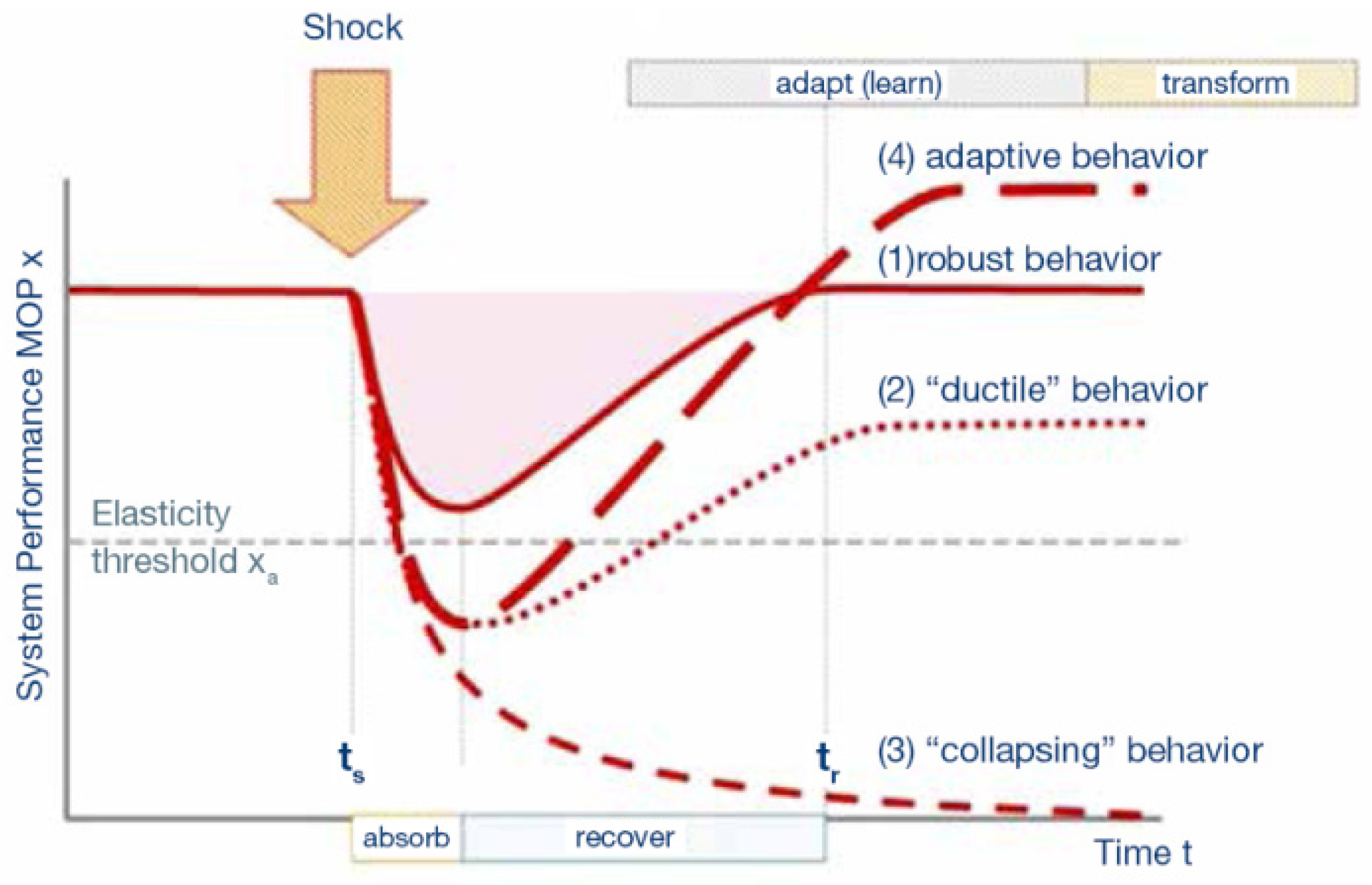
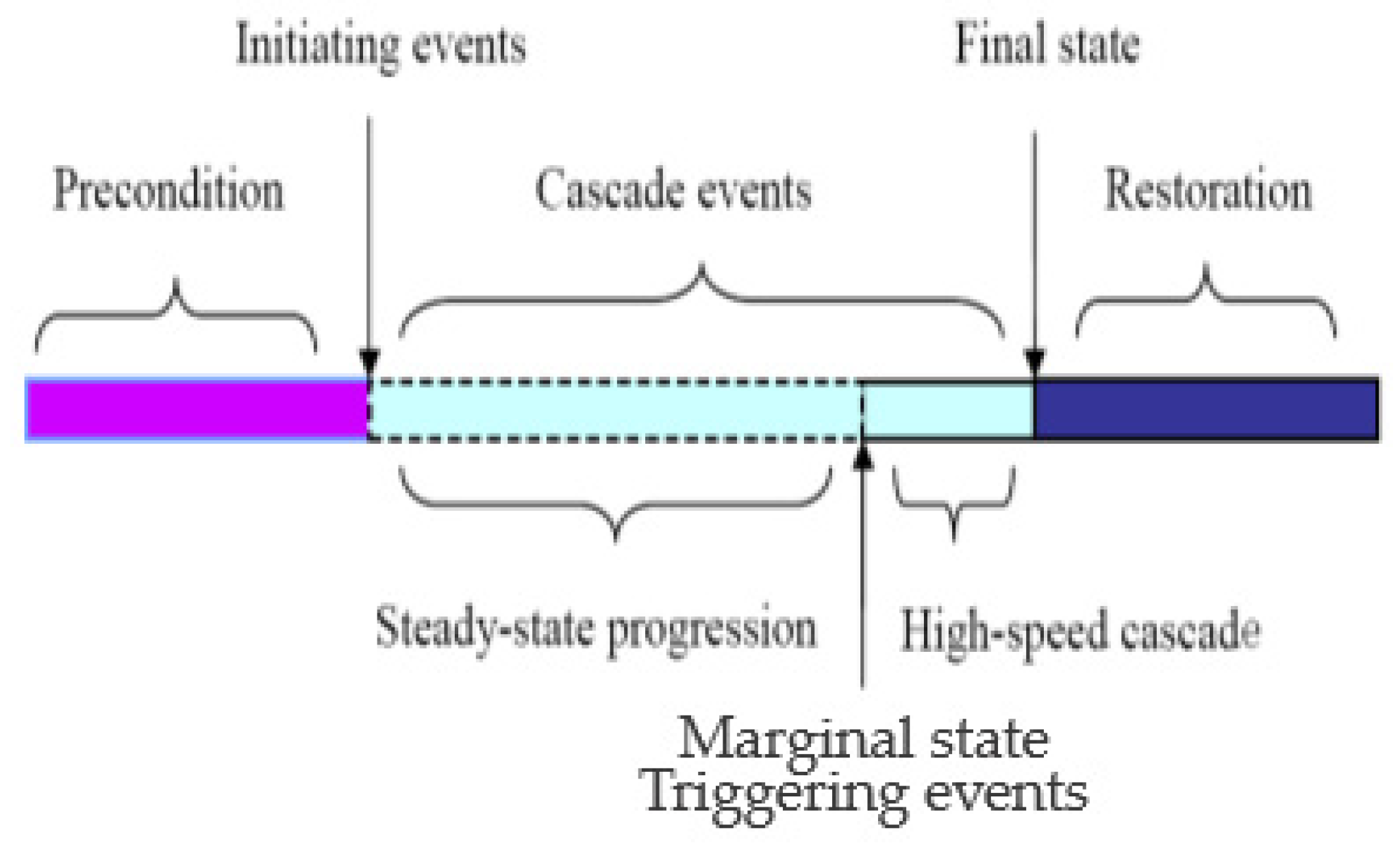
Publisher’s Note: MDPI stays neutral with regard to jurisdictional claims in published maps and institutional affiliations. |
© 2020 by the author. Licensee MDPI, Basel, Switzerland. This article is an open access article distributed under the terms and conditions of the Creative Commons Attribution (CC BY) license (http://creativecommons.org/licenses/by/4.0/).
Share and Cite
Voropai, N. Electric Power System Transformations: A Review of Main Prospects and Challenges. Energies 2020, 13, 5639. https://doi.org/10.3390/en13215639
Voropai N. Electric Power System Transformations: A Review of Main Prospects and Challenges. Energies. 2020; 13(21):5639. https://doi.org/10.3390/en13215639
Chicago/Turabian StyleVoropai, Nikolai. 2020. "Electric Power System Transformations: A Review of Main Prospects and Challenges" Energies 13, no. 21: 5639. https://doi.org/10.3390/en13215639
APA StyleVoropai, N. (2020). Electric Power System Transformations: A Review of Main Prospects and Challenges. Energies, 13(21), 5639. https://doi.org/10.3390/en13215639



